
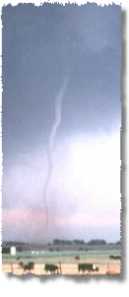 Tornado Facts
Tornado Facts
- A tornado WATCH means weather conditions are prime for a tornado.
- A tornado WARNING means a tornado has been sighted or indicated by radar.
- Around 1000 tornadoes occur each year in the U.S.
- Around 60 people are killed each year from them.
- Significant causes of death are collapsing buildings, flying debris, and car accidents.
- Tornadoes are caused by cold air blowing over an area of warm air, causing it to violently rise.
- Tornadoes usually occur in the late afternoon and evening.
- They usually last less than 10 minutes.
- They rotate counterclockwise in the northern hemisphere and clockwise in the southern, but not always.
- Oklahoma City has been hit by more tornadoes than any other city in the U.S. based on current tornado information.
Tornado Signs
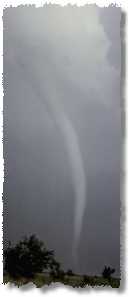 Thunderstorms happen often and very few of them create tornadoes but you should be wary of every one of them. Besides spawning tornados, thunderstorms bring along enough other hazards to make them dangerous and require family safety preparedness. Predicting a tornado is far from perfect, but some hints that a tornado may be brewing and ready to touch down include:
Thunderstorms happen often and very few of them create tornadoes but you should be wary of every one of them. Besides spawning tornados, thunderstorms bring along enough other hazards to make them dangerous and require family safety preparedness. Predicting a tornado is far from perfect, but some hints that a tornado may be brewing and ready to touch down include:
- strong rotation visible in the cloud base
- greenish, dark sky
- large high wall of clouds
- large hail
- a visible funnel shaped cloud
- a loud roaring sound, stronger than the consistent wind
- very calm wind during an ongoing storm
- small, bright flashes at ground level under a thunderstorm in the distance could be a tornado snapping power lines
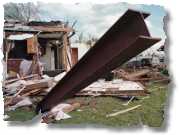 Before a Tornado
Before a Tornado
The best thing you can do is move someplace where tornadoes are very rare. If you have a house in a tornado zone, every year is a gamble if it will be struck.
Since tornadoes are random, chaotic, and sporadic, the survival of property has a lot to do with luck. If your house is hit dead-on by a tornado, it's going to be hurt.
But, here are some tornado safety tips to improve your odds:
-
Home Construction:
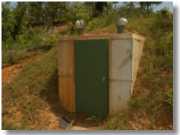
- extra fasteners for roof decking to hold against strong winds
- special connector clips between roof trusses and walls
- design good roof angles to minimize wind effects
- anchor the house to its foundation
- situate your house to use natural barriers such as hills and trees
- build a storm shelter or strengthened safe room
-
Preparedness:
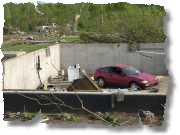
- Make a family plan and practice it
- Identify which location in your home will be the 'tornado shelter'
- Do not put heavy furniture or appliances on the floor directly above your shelter location
- Have a meeting place so absent family members can check in after the disaster
- Know where community tornado shelters are located
- Store toys, tools, and outdoor furniture in a sturdy shed or garage
During a Tornado

- If you are in a mobile home, get out. You have better odds outside.
- Grab your family emergency kit
- Go to your safe room or shelter
- Crouch down, face down
- Place a mattress or thick blanket over you for protection against glass and debris
- Cover your head with your arms
- Wait it out
- If you are in a vehicle in the tornado's path:
- Quickly park out of the traffic lanes
- If the tornado is a ways away, take some time to monitor it to see if it is coming right at you or angling to your right or left. If it appears to be standing still but possibly growing larger, then it is coming right at you and you need to drive out of its path. If it is moving to left or right, then you should move the opposite direction or keep monitoring.
- Grab your vehicle emergency kit
- Get out of your vehicle
- Find shelter in a sturdy building
- Do not stay in your car and do NOT seek shelter under a bridge or ovepass
- If you are outside with no way to reach shelter:
- Get away from cars, trees, and other large objects that may be blown onto you
- Seek low ground rather than hilltops
- Lie flat face down
- Cross your forearms over the back of your head for protection against flying debris
After a Tornado
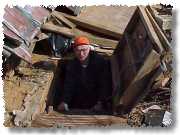
- Check your surroundings for hazards and get your family to a secure place
- Give first aid to those in need
- Shut off gas, electricity, and water if those systems have been damaged
- Avoid wires and standing water to prevent electric shock
- Walk carefully to avoid stepping on glass, nails, and sharp debris
- Stay out of buildings that are not structurally sound
- Only use flashlights for light, not candles due to possible gas leaks
- Use your radio to hear news and instructions
- Assess what resources are available and determine your next steps
- Do not ignore small cuts or puncture wounds - clean and treat all cuts and scrapes
- Use your cellphone to call your out-of-town emergency contact and check in.
- Contact your insurance representative
- Make minor repairs to your house to prevent further damage, if it is safe. Such as attaching a tarp over a ruined roof
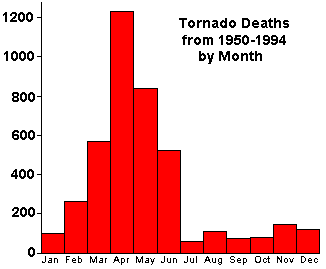
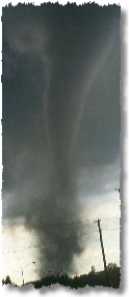
- Scientific tornado information shows that those early in the season are more intense on average than those occurring later.
- Early season tornadoes often occur after dark since the daylight hours are shorter. Since tornadoes are more difficult to identify at night, more people are caught unaware.
- Tornadoes hit the southern states early in the season. Houses there are often of lesser quality, set on blocks, and have no basements due to ground water levels, temperate climate, and rural poverty. People in these homes are less protected.
The Fujita Scale is a way of categorizing tornadoes in relation to damage done and estimated wind speed. The scale is from F0 to F6.
The Fujita Scale
| Scale | Intensity | Wind Speed | Type of Damage Done |
| F0 | Gale tornado | 40-72 mph | Some damage to chimneys; breaks branches off trees; pushes over shallow-rooted trees; damages sign boards. |
| F1 | Moderate tornado | 73-112 mph | The lower limit is the beginning of hurricane wind speed; peels surface off roofs; mobile homes pushed off foundations or overturned; moving autos pushed off the roads; attached garages may be destroyed. |
| F2 | Significant tornado | 113-157 mph | Considerable damage. Roofs torn off frame houses; mobile homes demolished; boxcars pushed over; large trees snapped or uprooted; light object missiles generated. |
| F3 | Severe tornado | 158-206 mph | Roof and some walls torn off well constructed houses; trains overturned; most trees in forests uprooted |
| F4 | Devastating tornado | 207-260 mph | Well-constructed houses leveled; structures with weak foundations blown off some distance; cars thrown and large missiles generated. |
| F5 | Incredible tornado | 261-318 mph | Strong frame houses lifted off foundations and carried considerable distances to disintegrate; automobile sized missiles fly through the air in excess of 100 meters; trees debarked; steel re-inforced concrete structures badly damaged. |
| F6 | Inconceivable tornado | 319-379 mph | These winds are very unlikely. The small area of damage they might produce would probably not be recognizable along with the mess produced by F4 and F5 wind that would surround the F6 winds. Missiles, such as cars and refrigerators would do serious secondary damage that could not be directly identified as F6 damage. If this level is ever achieved, evidence for it might only be found in some manner of ground swirl pattern, for it may never be identifiable through engineering studies |
Myths and Misinformation
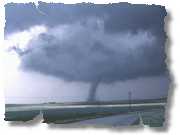
- Opening windows on your home does not help at all during a tornado. If anything, it wastes time you could be using to get to shelter and lets rainwater come in even if the windows don't break. The energy in a tornado will easily open your windows by throwing rocks at them, blowing on them, or just smashing your house with an available tree or car. The pressure changes from a tornado will not cause your house to explode because the building is not airtight and the winds will have broken the windows by the time the area of extreme pressure changes reaches your location.
 The safest location in your home is not necessarily the southwest corner of your basement. It is wherever you have a small, windowless, interior room on the lowest level of your house.
The safest location in your home is not necessarily the southwest corner of your basement. It is wherever you have a small, windowless, interior room on the lowest level of your house.- Sheltering under an overpass is the worst choice you can make if you are in a car. Laying in a ditch is a much better choice since the winds are less severe the lower you are to ground. There is no horizontal protection under an overpass and people can be (and have been) swept away and killed, or at least pummeled with literally tons of flying debris.
- Cities offer no inherent protection against tornados. Neither do rivers, lakes, forests, or big buildings - tornados plow ahead based on the weather driving them and that's all.
- Mobile homes do not attract tornados. But, when they do get hit, there is much more damage since they are so susceptible to wind damage.

Find Emergency and Disaster Info at www.EmergencyDude.com

